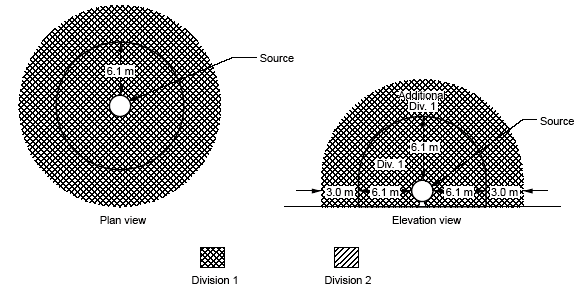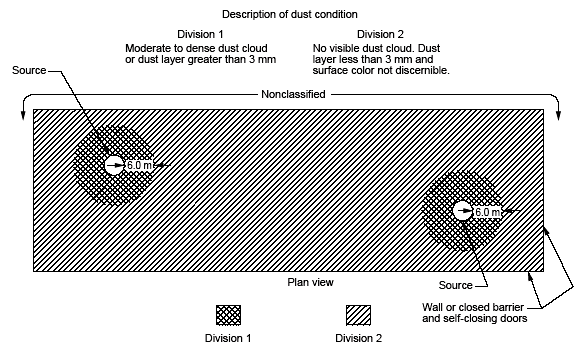Prerequisite of following article to start reading this article Hazardous Area Classification NEC & Principles of Class I Areas – Hazardous Area Classification NEC.
Principles of Class II Areas – Hazardous Area Classification NEC
Class II Areas
Class II areas are areas in which the combustible material is dust. See Figures 11 to 18 for characteristics of various types of combustible dust.
Figure 11 – Range of Explosive Concentrations of Hazardous Gases and Vapors, Based upon Volume (Upper and Lower Flammable Limits)
Figure 12 – Permissible Concentrations of Flammable Gas or Vapor-Air Mixtures

Figure 13 – Group F or G Dust – Indoors Unrestricted Area, Open or Semi-enclosed Equipment

Figure 14 – Group E Dust – Indoor Unrestricted Area, Open or Semi-enclosed Operating Equipment

Figure 15 – Group F or Group G Dust – Indoor Unrestricted Area, Operating Equipment Enclosed

Figure 16 – Group F or G Dust – Indoors Unrestricted Area, Operating Equipment Enclosed

Figure 17 – Group E Dust – Indoor Walled Off Area, Operating Equipment Enclosed

Figure 18 – Group F or Group G – Indoor Walled Off Area, Operating Equipment Open or Semi-enclosed
Figure 19 – Group F or Group G – Indoor Walled Off Area, Multiple Operating Equipment

Figure 20 – Group F or Group G – Indoor Unrestricted Area, Ventilated Bagging Head

Figure 21 – System Containment Test Flowchart

Class II Divisions
Class II has two Divisions: Division 1 and Division 2.
Division 1
- In Division 1 areas, combustible dust is in the air under normal conditions in quantities sufficient to produce explosive or ignitable mixtures.
- Mechanical failure or abnormal operation of equipment may cause the production of an explosive or ignitable dust mixture, as well as a source of ignition, through simultaneous failure of electrical equipment or actuation of an electrical protective device.
- Group E dust may be present in hazardous quantities.
Division 2
- In Division 2 areas, combustible dust is not usually in the air in sufficient quantities to produce an explosive or ignitable mixture.
- Dust accumulations are usually insufficient to interfere with the normal operation of electrical equipment.
- Dust accumulation in or on electrical equipment may be sufficient to interfere with the safe dissipation of heat from electrical equipment.
- Dust accumulation in or on electrical equipment may be ignitable by abnormal operation or failure of the equipment.
Unclassified Locations
Locations that do not classify as Division 1 or 2 shall be specified as unclassified.
Groups
See section , Class II Group Definitions.
Conditions Necessary for Ignition
In Class II locations ignition may occur under three different sets of conditions:
- Condition set No. 1:
a. Combustible dust is present
b. The combustible dust is suspended in air in the proportions required to produce an ignitable mixture
c. There is an energy release from electrical equipment intense enough to cause ignition - Condition set No. 2:
a. A combustible dust is present
b. Dust is layered on electrical equipment sufficiently thick to interfere with the dissipation of heat, and the dust layer is allowed to reach its ignition temperature
c. The external temperature of the electrical equipment is high enough to cause the dust to reach its ignition temperature, or to dry out the dust and cause over-heating - Condition set No. 3:
a. Group E dust is present
b. The dust is layered or in suspension in hazardous quantities
c. Tracking is sufficient to cause ignition
Concentration Criteria
The following dust settlement information shall be used as a basis when developing an area classification recommendation. This method is based on dust level build up on a large section of horizontal surface over a 24 hour period, and shall apply to only Group F or G dusts:
a. Dust thicknesses over 3.0 mm shall be classified as a Division 1 area
b. Dust thickness 3.0 mm or less and with indiscernible surface color shall be classified as a Division 2 area
c. If the surface color is discernible under the layer of dust, the area shall be considered unclassified
Defining of Classified Locations
The following factors shall be considered when defining classified areas for Group F and G dust locations:
a. The combustible material involved
b. Bulk density of the material
c. Particle size of the material
d. Density of the particles
e. Process or storage pressure
f. Size of the leak opening
g. Quantity of the release
h. The dust collection system
i. The housekeeping
j. Presence of flammable or combustible gas
Continue……. Subsequent Articles for this post are
Principles of Class III Areas – Hazardous Area Classification NEC

